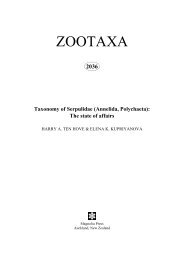Create successful ePaper yourself
Turn your PDF publications into a flip-book with our unique Google optimized e-Paper software.
and in Martius (1823–1837) as “fluvii Solimoës”, presumably in Brazil (Amazonas). All the specimens cited<br />
here come from further west than the most westward point of Martius’ journey in modern-day Colombia, with<br />
the exception of Aguirre-Galviz 1152 from Colombia (Amazonas).<br />
12.2. Desmoncus mitis subsp. ecirratus Henderson, subsp. nov. (Appendix IV Plate 16)<br />
A subspeciebus aliis pinnis paucis ovatis atque cirro normaliter absenti differt.<br />
Type:—BRAZIL. Rondônia: road to casserite mine, north bank of Rio Madeira in Serra dos Tres Irmãos 8 km above<br />
Mutumparaná, 5 July 1968, G. Prance, E. Forero, L. Coêlho, J. Ramos & L. Farias 5636 (holotype INPA!, isotype<br />
NY!).<br />
Leaf sheaths non-spiny, rarely sparsely spiny; rachises 20.9(8.0–41.0) cm long; pinnae ovate, 3(2–5) per side<br />
of rachis; cirri usually absent, the rachis terminating beyond the distalmost pair of pinnae in a short ‘stub’.<br />
Distribution and habitat:—From 3°30’–10°58’S and 56°00’–73°14’W in the south–central Amazon<br />
region of Peru (Ucayali), Brazil (Acre, Amazonas, Mato Grosso, Rondônia) and Bolivia (Beni, Pando) with<br />
an outlier in Peru (Loreto) at 177(120–300) m elevation in lowland rainforest (Fig. 9).<br />
Taxonomic notes:—This taxon was mistakenly referred to by Henderson (1995) as Desmoncus mitis var.<br />
leptoclonos, based on D. leptoclonos Dammer. However, this name is pre-occupied by D. leptoclonos Drude.<br />
Subspecific variation:—The outlying specimen (Asplund 14687) from Loreto, Peru, has much wider<br />
pinnae than other specimens. Some specimens are described on labels as being non–climbers. On some<br />
specimens (e.g., Moreno 163, Schunke 15033, Nee 34990, Forero 6384) there are some leaves with weakly<br />
developed cirri as well as leaves with the more usual poorly-developed cirri; on a few other specimens there<br />
are weakly developed cirri. Specimens from the eastern part of the range, from eastern Acre, Rondônia, Mato<br />
Grosso, and adjacent Bolivia usually have 2 pinnae per side of the shorter rachis, and these have very few<br />
spinules at the bases. Specimens from the western part of the range, from western Acre and adjacent Peru tend<br />
to have 3 pinnae per side of the longer rachis, and usually have spinulose pinnae bases. These specimens<br />
overlap with those of D. mitis subsp. leptospadix.<br />
12.3. Desmoncus mitis subsp. leptospadix (Martius) Henderson, comb. & stat. nov.<br />
Basionym: Desmoncus leptospadix Martius (1844: 52). Atitara leptospadix (Martius) Kuntze (1891: 727). Desmoncus<br />
mitis var. leptospadix (Martius) Henderson (1995: 228). Type:—PERU. Loreto: Maynas, Yurimaguas, no date, E.<br />
Poeppig 2207 (holotype G n.v., holotype image!). Epitype (here designated):—PERU. Loreto: Santa Rosa, lower<br />
Río Huallaga below Yurimaguas, ca. 125 m, 1–5 September 1929, E. Killip & A. Smith 28807 (epitype NY!,<br />
isoepitype US!).<br />
Leaf sheaths non-spiny, rarely sparsely spiny; rachises 35.0(17.2–76.0) cm long; pinnae ovate, 6(3–11) per<br />
side of rachis; cirri usually well-developed.<br />
Distribution and habitat:—From 0°52’–11°46’S and 59°00’–77°40’W in the western Amazon region in<br />
Colombia (Amazonas), Peru (Amazonas, Cuzco, Huánuco, Loreto, Ucayali), and Brazil (Acre, Amazonas) at<br />
166(100–400) m elevation in lowland rainforest (Fig. 9).<br />
Taxonomic notes:—Henderson (1995) referred to this taxon as Desmoncus mitis var. leptospadix<br />
(Martius) Henderson, based on D. leptospadix Martius. The type of this is sterile and an epitype is therefore<br />
designated.<br />
Subspecific variation:—Most specimens from Maynas, Loreto, Peru have multiple (2–3) inflorescences<br />
at a node. Two specimens (Prance 12310, 12490), both from the same locality in western Acre, Brazil have<br />
larger fruits than usual; others from the same area have normal fruits. Most specimens from western Acre<br />
have smaller leaves than usual. A few specimens from the western part of the range have spiny peduncular<br />
A REVISION OF DESMONCUS (ARECACEAE)<br />
Phytotaxa 35 © 2011 <strong>Magnolia</strong> <strong>Press</strong> 33
















